The OnePlus 2 Review
by Brandon Chester on December 14, 2015 8:00 AM EST- Posted in
- Smartphones
- Mobile
- OnePlus
- OnePlus 2
Display
At this point, it's hard to excuse shipping a smartphone without a great display. Not just great in terms of resolution, contrast, and brightness, but also great in terms of color accuracy. We've seen even inexpensive smartphones like the Moto G and the Lumia 640 achieve levels of color accuracy that weren't achieved even by many flagship smartphones only a few years ago. As for OnePlus, the OnePlus One was notable for bringing a very accurate and high resolution display to a low price point, and at the time it was one of the best displays you could get on a smartphone. With that being achieved by their very first smartphone, OnePlus has some big shoes to fill with its follow up.
To analyze the quality of a smartphone's display we run it through our custom display workflow which measures accuracy relative to the sRGB color space. Measurements are performed with an i1Pro 2 spectrophotometer, with the exception of contrast measurements which are done with an i1Display Pro colorimeter. Data is collected and organized using SpectraCal's CalMAN 5 software.
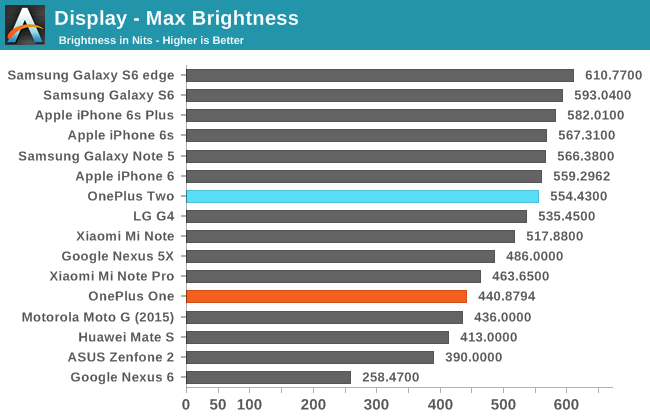
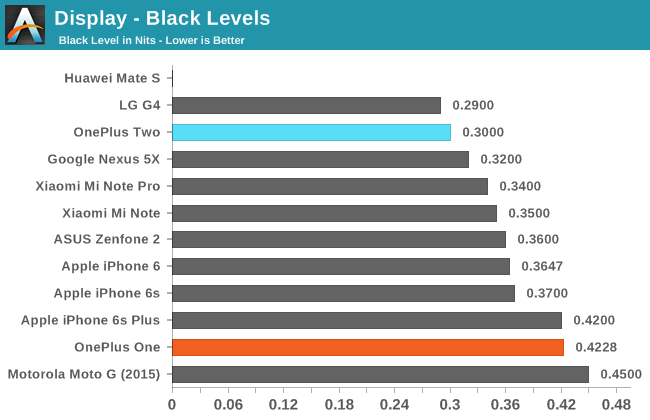
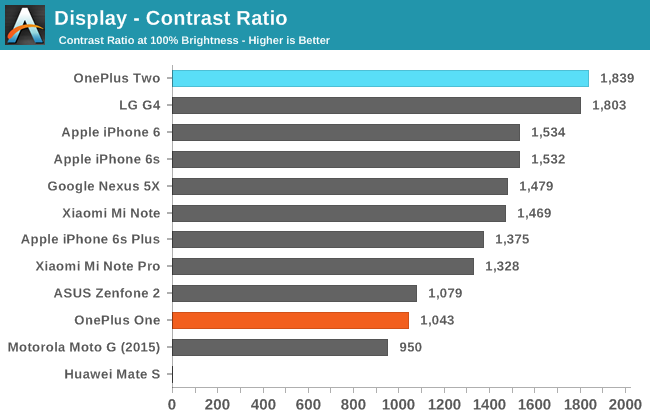
Out of the box, things look promising for the OnePlus 2. The display can get quite bright, and despite that it can also get quite dark, which leads to it achieving the best contrast ratio on record for an LCD device.
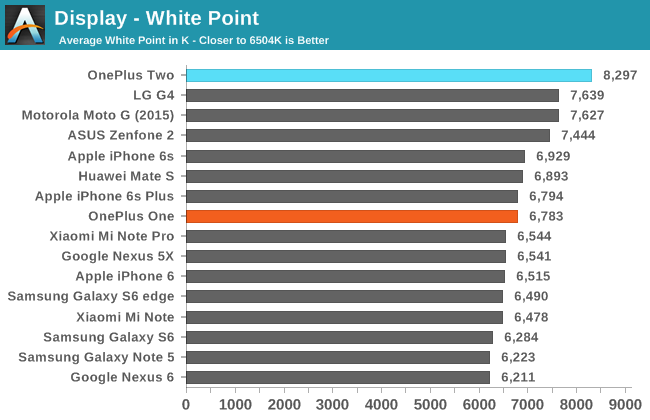
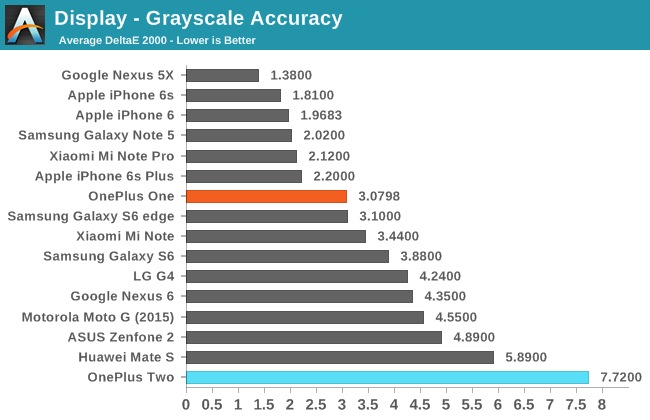
Unfortunately, there's not much good news beyond high brightness and deep blacks. Greyscale accuracy on the OnePlus 2 is extremely poor. Right out of the gate, there's a large imbalance between the red and blue components that make up the shades of grey, and that gap grows increasingly large as you move toward white. The gamma is also quite a disaster, with a high degree of irregularity. Honestly I don't really know what to say, as this result is quite shocking when one looks back at how accurate the OnePlus One was. The OnePlus 2 is simply too blue, and even without the blue shift the highly irregular gamma will cause issues with both greyscale and color mixture rendition.
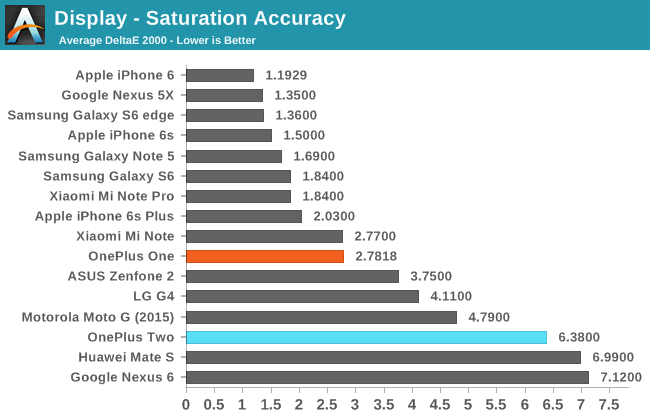
Moving on to the saturation sweep test, the OnePlus 2 again performs poorly. Every primary and secondary color with the exception of blue has a high degree of error, particularly red, magenta, and cyan. While in this test the phone narrowly avoids being the worst result on the chart, it's not very far off, and can hardly be called accurate. There's clear saturation compression occurring, with OnePlus managing to be accurate for more of the 100% saturation values, but being undersaturated for most values below that.

With poor greyscale accuracy, irregular gamma, and inaccurate rendition of primary and secondary colors, there's no hope for accurate color mixtures on the OnePlus 2's display. There's really not much more to be said. We're not talking about the kind of inaccuracy that you'd get from an oversaturated panel, but instead just general inaccuracy where no color is quite how it should be. It seems like OnePlus just focused on making sure the panel matched the sRGB gamut and put no effort into any further calibration.
The display quality of the OnePlus 2 is not impressive at all. For a $400 phone this is simply unacceptable, and it's such an enormous regression from the OnePlus One. What's even more problematic is how OnePlus keeps tweaking the display settings with their updates, and you never know whether it's going to change for the better or for the worse. I've seen the gamma curve change significantly, but the overall accuracy didn't improve for the better because some aspects improved and others got worse. In any case, I don't know what happened when OnePlus was deciding upon the display attributes they would be targeting, but as far as being accurate to the Rec. 709 standard goes the OnePlus 2 is actually one of the worst devices on record, and I'm at a loss as to how to explain why they allowed it to fall so far behind the original.




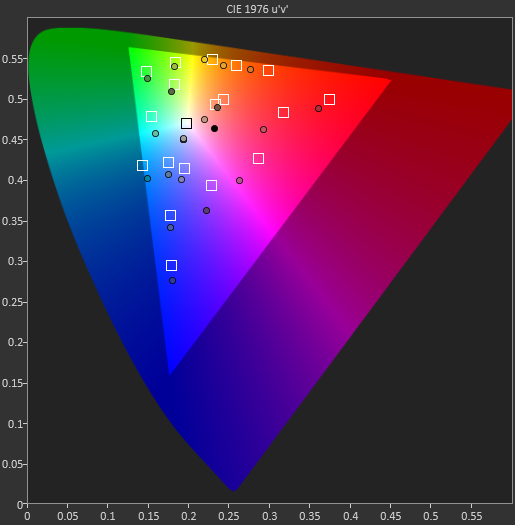








132 Comments
View All Comments
zeeBomb - Tuesday, December 15, 2015 - link
Wow. Boeffla better than AK? Or both have their strengths & weaknesses...dunno why OP will just shutdown 2 A57s and render it as a 6 core device :/Does it get reaaaly hot on everyday usage too?
fguerro - Tuesday, December 15, 2015 - link
I don't notice the phone getting significantly hotter with the changes in the Boeffla kernel.fguerro - Monday, December 14, 2015 - link
With my OnePlus 2 and custom kernel, running Chrome:Kraken 1.1 = 4419.8ms
Google Octane = 8016
WebXPRT 2015 = 118
MarcSP - Monday, December 14, 2015 - link
Absolutely agree with you.MarcSP - Monday, December 14, 2015 - link
So you review "random" Android devices, but do not review the flagship device of the third mobile platform?And please don't say "2% marketshare worlwide". First, in many countries in Europe it has more than 10%, even more than iPhone. Second, products should be reviewed by relevance, not only marketshare. I think a flasgship phone for one of the major tech companies in the world, with the most used OS (in this case mobile version) is quite relevant.
I am specially interested in the screen: some reviewers said "washed out" and others "very accurate colors". I assume the first group are the ones that like TV sets in the store, with over the top colors and contrast, but I would prefer to see Anandtech numbers to make sure :).
Brandon Chester - Monday, December 14, 2015 - link
Microsoft and their PR agencies have not found a way to send a non-AT&T branded and locked unit to Brett. Might be worth petitioning them to figure that situation out.Vishalaestro - Monday, December 14, 2015 - link
you guys need to review the Asus zenfone 2 laser for the fact that how important the ISP is for camera performance , the camera is night and day better than the Asus zenfone 2 with the intel chipsets.zeeBomb - Tuesday, December 15, 2015 - link
Honestly its just a lot faster to snap, and yeah images are marginally better.LiverpoolFC5903 - Tuesday, December 15, 2015 - link
Quick question from a n00b. I thought the 4 A57 cores are synchronous, as in all four run at the same frequency when active or none at all. Same with the A53 cluster to my knowledge. But your statement about two A57 cores running with two of them shut sort of contradicts that.I also use Treqn profiler app from Qualcom to study CPU performance for different workloads and I have noticed that all four A57 cores show the same frequency curve when mapping CPU use in a graph.
Anyone?
So how does it work?
"For example, in this case the Cortex A57 cores are in use during the web test, while in general they never get used at all during web browsing, and in more intensive situations the best case is that there are two A57 cores in use at some frequency and the other two are shut off."
Andrei Frumusanu - Tuesday, December 15, 2015 - link
Frequency is independent from power states, cores can be shut off or power gated in idle even if the cluster frequency is high.